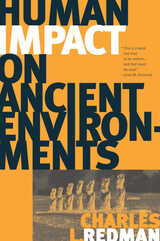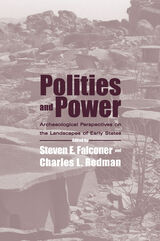2 books by Redman, Charles L.

Human Impact on Ancient Environments
Charles L. Redman
University of Arizona Press, 1999
Threats to biodiversity, food shortages, urban sprawl . . . lessons for environmental problems that confront us today may well be found in the past. The archaeological record contains hundreds of situations in which societies developed long-term sustainable relationships with their environments—and thousands in which the relationships were destructive. Charles Redman demonstrates that much can be learned from an improved understanding of peoples who, through seemingly rational decisions, degraded their environments and threatened their own survival. By discussing archaeological case studies from around the world—from the deforestation of the Mayan lowlands to soil erosion in ancient Greece to the almost total depletion of resources on Easter Island—Redman reveals the long-range coevolution of culture and environment and clearly shows the impact that ancient peoples had on their world. These case studies focus on four themes: habitat transformation and animal extinctions, agricultural practices, urban growth, and the forces that accompany complex society. They show that humankind's commitment to agriculture has had cultural consequences that have conditioned our perception of the environment and reveal that societies before European contact did not necessarily live the utopian existences that have been popularly supposed. Whereas most books on this topic tend to treat human societies as mere reactors to environmental stimuli, Redman's volume shows them to be active participants in complex and evolving ecological relationships. Human Impact on Ancient Environments demonstrates how archaeological research can provide unique insights into the nature of human stewardship of the Earth and can permanently alter the way we think about humans and the environment.
[more]

Polities and Power
Archaeological Perspectives on the Landscapes of Early States
Edited by Steven E. Falconer and Charles L. Redman
University of Arizona Press, 2009
This distinctive book is the first to address the topic of landscape archaeology in early states from a truly global perspective. It provides an excellent introduction to—and overview of—the discipline today. The volume grew out of the Fifth Biennial Meeting of the Complex Societies Group, whose theme, States and the Landscape, paid tribute to the work of Robert McC. Adams. When Adams began publishing in the 1960s, the interdependence of cities and their countrysides, and the information revealed through the spatial patterning of communities, went largely unrecognized. Today, as this useful collection makes clear, these interpretive insights are fundamental to all archaeologists who investigate the roles of complex polities in their landscapes.
Polities and Power features detailed studies from an intentionally disparate array of regions, including Mesoamerica, Andean South America, southwestern Asia, East Africa, and the Indian subcontinent. Each chapter or pair of chapters is followed by a critical commentary. In concert, these studies strive to infer social, political, and economic meaning from archaeologically discerned landscapes associated with societies that incorporate some expression of state authority. The contributions engage a variety of themes, including the significance of landscapes as they condition and reflect complex polities; the interplay of natural and cultural elements in defining landscapes of state; archaeological landscapes as ever-dynamic entities; and archaeological landscapes as recursive structures, reflected in palimpsests of human activity.
Individually, many of these contributions are provocative, even controversial. Taken together, they reveal the contours of landscape archaeology at this particular evolutionary moment.
Polities and Power features detailed studies from an intentionally disparate array of regions, including Mesoamerica, Andean South America, southwestern Asia, East Africa, and the Indian subcontinent. Each chapter or pair of chapters is followed by a critical commentary. In concert, these studies strive to infer social, political, and economic meaning from archaeologically discerned landscapes associated with societies that incorporate some expression of state authority. The contributions engage a variety of themes, including the significance of landscapes as they condition and reflect complex polities; the interplay of natural and cultural elements in defining landscapes of state; archaeological landscapes as ever-dynamic entities; and archaeological landscapes as recursive structures, reflected in palimpsests of human activity.
Individually, many of these contributions are provocative, even controversial. Taken together, they reveal the contours of landscape archaeology at this particular evolutionary moment.
[more]
READERS
Browse our collection.
PUBLISHERS
See BiblioVault's publisher services.
STUDENT SERVICES
Files for college accessibility offices.
UChicago Accessibility Resources
home | accessibility | search | about | contact us
BiblioVault ® 2001 - 2024
The University of Chicago Press









